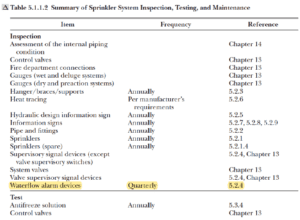Navigating NFPA 25

Many know that NFPA 25 is the Standard for Inspection, Testing, and Maintenance of Water-Based Fire Protection Systems, but what many do not know is how to efficiently use the standard. Hopefully, by the end of this article, there will be a better understanding of the layout of the standard and how to use it more efficiently.
It is relatively simple to navigate the standard once the layout is better understood. There are 16 chapters in the standard. Chapters 1-4 are the administrative chapters and are the same as most NFPA standards. In 1999, NFPA created the manual of style, to better align the first four chapters. Chapter 1 is the scope and purpose of the document, Chapter 2 is references, Chapter 3 is definitions, and Chapter 4 is general requirements. This does not mean the same information is found in each standard, for instance you would not find the scope of inspection, testing, and maintenance (ITM) in Chapter 1 of NFPA 13 the Standard for Installation of Sprinkler Systems. Chapter 4 is the most important chapter for building owner’s, owner’s representatives, and the Authority Having Jurisdiction (AHJ). This chapter lays out the owner’s responsibilities to conduct minimum ITM on their sprinkler systems as well as what to do when any changes are made to the sprinkler system or the building including changes in water supplies.
Chapters 5-13 are where contractors spend most of their time. These chapters layout the frequencies and ITM procedures. Each chapter except for ,Chapter 12, will have two tables. The first table is called the “1.1.2” table. It is in the beginning of each chapter and appropriately labeled per chapter, e.g., Chapter 5 table would be 5.1.1.2. This table provides a quick reference for the ITM of the most common components. It will show all the inspection items, then testing, and then the maintenance requirements. It will also provide the frequency of the task and a section reference. So, if we wanted to know the frequency for inspection of vane type flow switches, we would go to Table 5.1.1.2 then look under the inspection items, find waterflow alarms. We then can see they are required to be inspected quarterly. If more detail is needed, Section 5.2.4 provides the additional information. All chapters again except for Chapter 12, which is water mist systems will have this table. Also, note that the chapter will be in the same order, meaning that all the inspection items will be first, then the testing items and finally the maintenance items.

Photo Courtesy of NFPA
The second table in each chapter is the component action table. Very few are aware of this table and can be found at the end of each chapter, once again apart from Chapter 12. This table indicates what is required when a component is adjusted, repaired, or replaced. An example would be, if more than twenty sprinklers are replaced, the table tells us to conduct a hydrostatic test in accordance with NFPA 13. This table is important because many times the service technician is not always the inspector and may not use NFPA 25 however, they should be because they are still required to follow the requirements in these tables when they are making corrections or repairs to a sprinkler system.
Chapter 14 is where the requirements for conducting internal assessments of sprinkler pipe can be found. As well as the requirements for conducting obstruction investigations. Chapter 15 is the chapter that provides the process for how to deal with impairments, including the requirements of the impairment coordinator and when a fire watch is required. Chapter 16 is new in the 2014 edition of NFPA 25 and is the chapter that covers small board and care facilities, which typically consist of 13D installations. We know by reading chapter scope and purpose that 13D systems, The Standard for the Installation of One- and Two- Family Dwellings and Manufactured Homes, are not covered in this standard. Chapter 16 provides the only exception to this rule.
There are several annexes, but the most widely used is Annex A. Annex A provides explanatory language that provides additional information for a specific section. This information could include a process to conduct an ITM or clarify why the section was put into the standard. Each section in Annex A, will follow the section in the body of the standard. Any section in the body of the standard that has an asterisk behind it will have a correlating section in Annex A. For example, section 5.2.5* Hydraulic Design Information Sign, would be in Annex A, A.5.2.5 with whatever the explanatory material is. The remaining annexes will have varying information. The thing to understand about anything in any annex is that it is not enforceable, therefore it should not be cited on an inspection report.
Hopefully, this crash course helps to clarify how NFPA 25 is laid out and how to use the standard more efficiently. It is important that anyone using this standard knows what is in the standard, how to use it, and most importantly their role, whether it is an , building owner, or contractor. Each play a different but significant role in the Inspection, Maintenance, and Testing of fire sprinkler systems.
